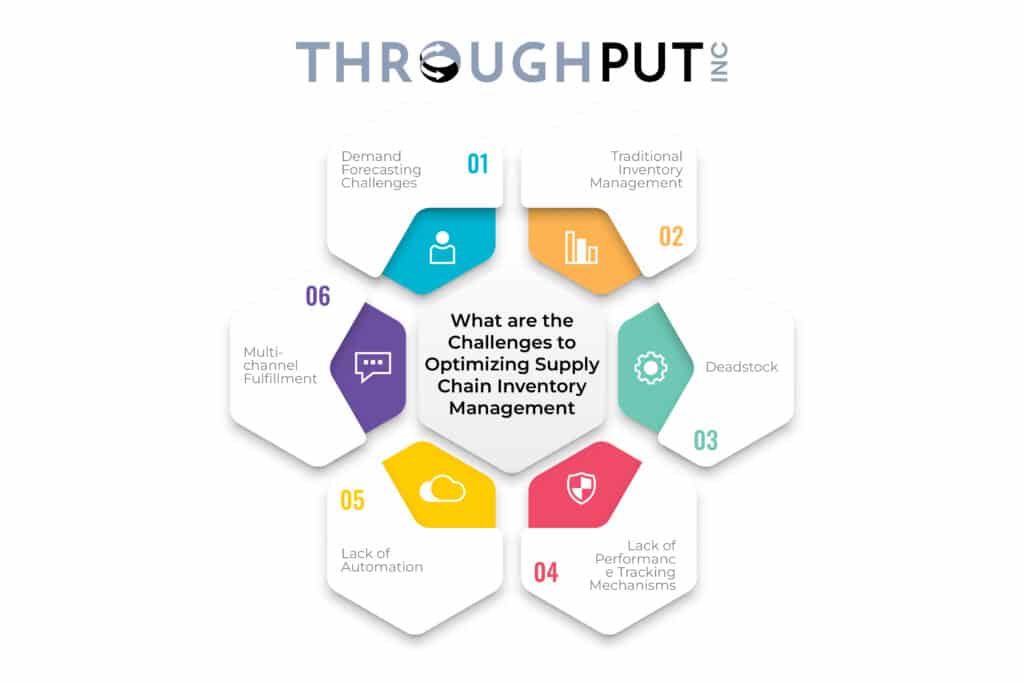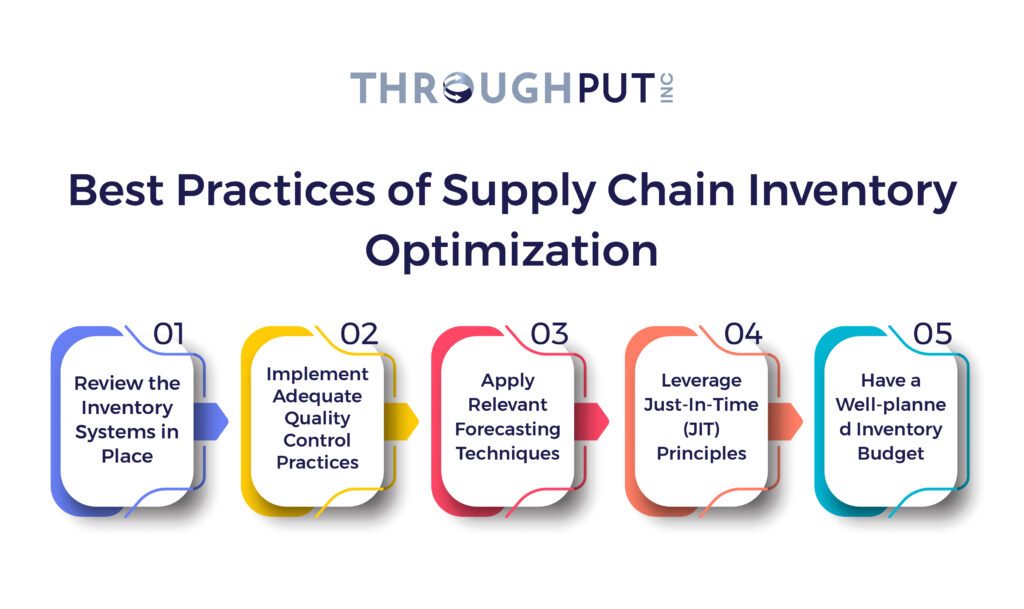Best Practices for Supply Chain Inventory Optimization in 2025

As supply chain operators and managers, we’re well aware that supply chain inventory optimization is a cornerstone of supply chain management.
It’s often the first step leading to optimal efficiency rates, reduced overhead costs, and successful risk mitigation that ensures the smooth flow of materials and information.
In this comprehensive blog post, we will delve into the benefits of supply chain inventory optimization, examine the key elements of inventory optimization, explore various inventory optimization techniques, examine the challenges associated with optimizing inventory management, and discuss the pivotal role that AI plays in inventory management.
What is Supply Chain Inventory Optimization?
Supply chain inventory optimization is defined as the process of managing inventory levels to meet customer demand while keeping the costs associated with holding inventory as low as possible. To successfully optimize their inventories, managers must balance the costs of carrying inventory against the costs of stockouts and lost sales.
This aspect constitutes a fundamental part of supply chain management that directly impacts the overall costs of operations, as well as material and operations flow in the whole supply chain.
Companies that efficiently manage their inventories enjoy many benefits, such as higher rates of cost-effectiveness, lower overhead costs, better risk management, optimal inventory management, and smoother material and information supply.
According to Loftware’s survey with supply chain professionals in 2023, More than half (52%) of companies currently host critical enterprise applications in the Cloud while 76% believe artificial intelligence (AI) will be an important part of their supply chain within the next three years.
Optimization targets the inventory level needed to satisfy current and future forecasted demand by utilizing demand optimization strategies.
Effectively managing the dynamic task of inventory levels is vital to the success of any business selling products.
Stock properly is necessary to avoid understocking, which undermines revenue or overstocking, resulting in reduced liquidity. Inventories imbalanced beyond a reasonable level generate losses and diminished bottom-line profits.
What are the Main Elements of Inventory Optimization?
To enhance supply chain efficiency, managers must approach supply chain inventory optimization from multiple perspectives. Though supply chain inventory optimization covers many aspects, it typically involves three crucial factors that must be effectively addressed.
The main elements of supply chain inventory optimization are:
1. Demand Forecasting
Precise demand forecasting plays a vital role in supply chain inventory optimization solutions. The approach to demand and supply chain forecasting depends on multiple factors, such as product type, service nature, industry category, and product life cycle stages.
While some forecasting techniques lean on past demand, others require sales team estimates.
A deep understanding of the inventory volume and product life cycle plays a crucial role in effective demand forecasting required for optimizing demand and discovering the position of SKUs in the life cycle.
2. Inventory Strategy
Managing product inventory requires thoroughly comprehending which products to stock, when, and how many. To optimize this process, many companies employ ABC analysis to classify products based on their annual consumption value to determine optimal quantities.
Additionally, identifying the appropriate safety stock to accommodate changes in demand or unexpected disruptions is crucial.
3. Stock Replenishment
Stock replenishment starts with determining when and how much each item needs to be reordered. Managers need to consider each supplier’s lead time and production cycles, as well as the reliability of their deliveries.
Supply chain managers also have to monitor goods currently in transit, not just those in stock at the warehouse. Both factors are essential to ensuring smooth operation and meeting customer demand.
How to Analyze Supply Chain Inventory?
Inventory analytics can go a long way in understanding and improving inventory performance. It’s up to the inventory manager to ensure the key performance indicators (KPIs) are aligned with the available inventory and work on identifying key areas that are performing well or those aspects that require attention.
All essential data points, including products, suppliers, procurement, purchases, and sales, can be tracked from the inventory management system, and the inventory goals can be further used to categorize inventory metrics for demand optimization.
What are the Best Approaches to Inventory Optimization for Supply Chains?
Various strategies are available to companies to effectively maintain control of their inventory levels and ultimately optimize their entire supply chain. When a mix of these methods is implemented, companies can adequately tackle the challenge of maintaining their inventory in proper balance with demand and decrease expenses associated with inventory management.
Vendor-Managed Inventory (VMI)
VMI is a technique used to transfer inventory management responsibilities to suppliers. This technique can help companies reduce the costs associated with managing inventory. Under VMI, suppliers are responsible for monitoring inventory levels and replenishing inventory as needed.
ABC Analysis
ABC analysis is a technique used to categorize inventory based on its value. Companies can use this technique to prioritize inventory management efforts and focus on the most valuable items. Under ABC analysis, inventory is categorized into three groups:
- A items, high-value items that require close monitoring.
- B items, which are medium-value items that require moderate monitoring.
- C items, which are low-value items that require minimal monitoring.
Economic Order Quantity (EOQ)
EOQ is a technique used to determine the optimal order quantity to minimize the costs associated with ordering and holding inventory. EOQ considers the costs of ordering inventory, the costs of maintaining inventory, and the demand for inventory.
EOQ can help companies reduce the costs of managing inventory and improve their inventory management processes.
Safety Stock Management
Safety stock is the amount of inventory held to protect against stockouts. Companies must have a clear understanding of the appropriate level of safety stock to ensure that they can meet customer demand. Safety stock management involves balancing the costs of holding safety stock against the costs of stockouts and lost sales.
What are the Challenges to Optimizing Supply Chain Inventory Management
Inventory management can be a complex and costly process for many businesses. Manual management can lead to incorrect inventory records, excessive or insufficient inventory buildup, and frequent unnecessary expenditure of time and financial resources.
There are several challenges that companies face when trying to optimize their inventory management, most of them can be pinned down to:

Demand Forecasting Challenges
Accurately predicting sales during fluctuating demand cycles is a core concern due to the challenge of achieving precise forecasting. When sales forecasting is imprecise, stocking levels become less accurate, ultimately leading to possible negative impacts on customer service levels.
Traditional Inventory Management
Most traditional inventory management methods need to be revised with modern e-commerce techniques. The more complex the volume of sales and bulk shipments, the more arduous conventional inventory management becomes.
Multi-channel Fulfillment
Navigating the modern retail landscape requires managing inventory levels to meet sales velocity. However, this task can be challenging due to the numerous order fulfillment channels and varying KPIs for online and offline stores. Consequently, this results in multiple complex variables that require careful consideration.
Deadstock
When certain products lose relevance, fall out of popularity, or become useless, they become dead stock and prevent proper supply chain inventory optimization. The longer they sit without being sold (typically over 12 months), the more excess inventory accumulates and can affect upcoming purchases of similar items, ultimately hindering general inventory management endeavors.
Lack of Automation
Most suppliers and retailers still rely on outdated, manual distribution processes. This lack of automation and digitization severely limits their ability to integrate technological solutions, such as Artificial Intelligence, that could boost efficiency.
The result is a slow and haphazard approach to stocking levels, as the sluggishness of physical processes hampers swift decision-making.
Lack of Performance Tracking Mechanisms
Keeping track of how well inventory is performing can help efforts to optimize it. Precise inventory tracking and reporting to measure tangible and intangible variables is essential for ramping efficiency. Product managers must vigilantly monitor daily fill rates and inventory turnover based on sales cycles to circumvent potential mishaps.
What are the Best Practices of Supply Chain Inventory Optimization?
To be successful in the supply chain industry, it is important to stay up-to-date on the latest trends and best practices. Here are our top 5 recommendations for continuous inventory optimization that lead to peak performance:

1. Review the Inventory Systems in Place
Employing an effective inventory review system can significantly facilitate the process of streamlining inventory management. Two primary types of review systems are the Continuous Review System and the Periodic Review.
In the former system, quantities of items are ordered in every cycle, and inventory levels are continually monitored to renew stocks whenever an item falls below a certain threshold amount.
Whereas in the latter system, items are ordered regularly along predetermined cycles based on quality levels, and no predetermined reorder levels are maintained.
2. Implement Adequate Quality Control Practices
An accurate quality control process ensures inventory quality is directly linked to customer satisfaction and business growth.
First, manufacturers can create checklists that provide all procedures to be followed while taking stock of products and then move to standard operating procedures to qualify or disqualify products.
Establishing common goals of inspection can help streamline quality check procedures. This supply chain inventory optimization best practice can avoid over or under-stocking as workers will no longer offer customers inappropriate merchandise.
3. Apply Relevant Forecasting Techniques
Manufacturers utilize a variety of supply chain inventory optimization techniques when predicting future stock trends to improve accuracy. These techniques function as checkpoints aimed at preventing over or under-stocking.
A combination of historical and predictive measures are employed along with computer-assisted multi-model simulators, working together to calculate inventory requirements in the fore-seeable future.
Certain manufacturers additionally consider AI-backed analytics to make predictions about future customer demands.
4. Leverage Just-In-Time (JIT) Principles
In response to increased consumer need for personalized items, numerous retailers and producers have implemented efficient inventory methods rooted in JIT principles throughout the last 20 years.
Utilizing strategic JIT manufacturing, purchasing, and delivery methods, these manufacturers significantly boost optimal supply chain and JIT efficiency by improving inventory purchasing and delivery processes as well as eliminating operational constraints within factories causing bottlenecks in inventory workflow, thereby wasting innovative potential.
5. Have a Well-planned Inventory Budget
An yearly inventory budget is commonplace for manufacturers. Typically devised before inventory acquisition, it covers the comprehensive expenses of maintaining inventory throughout the accounting period.
In addition to material costs, it accounts for stationary fixed and logistics costs, redeployment costs, and any miscellaneous charges which might affect ownership expenditure.
What is the Role of AI in Supply Chain Inventory Management
The core concept behind supply chain inventory optimization is to ensure adequate inventory is available in the correct quantity, at the right place, at the right time, and at the correct cost.
AI software leverages its predictive capabilities to enable companies to prioritize stock levels based on demand and profitability, thus reducing supply chain limitations. Using AI brings apparent benefits, such as accurate predictions of procurement levels and advanced real-time insights to optimize business performance by minimizing waste, then route optimization strategies are applied effectively.
With growing supply chain complexities, effective inventory management is the first stepping stone to enhanced warehouse practices.
Throughput’s Inventory Management Solution
Profitability is increased when harnessing real-time insights on inventory levels, tracking order status, and improving the sales process to boost customer satisfaction.
Improving the accuracy of inventory information avoids multiple reorders that drive up investment costs, enhance quality, and develop operational excellence.
Throughput utilizes data and reports effectively to improve decision-making processes and develop a competitive strategy that is more strategic and operational.
Its strong predictive capabilities provide concrete advantages to inventory managers:
- Prioritize stock levels based on profitability and demand.
- Ease out any supply chain disruptions.
- Arrive at accurate procurement levels for production and supply.
- Accurately forecast demand and revenue.
- Ensure effective route optimization and alter them when needed.
- Eliminate any wastage in the form of damaged items.
- Work on predictive analytics to optimize business performance when needed
ThroughPut’s AI-powered inventory management solution is equipped with powerful intelligence to tackle supply chain challenges of congested bottlenecks or close margin profits.
Find out how ThroughPut helps you gain superior supply chain inventory optimization with complete visibility across your supply chain operations – book a demo with us.

